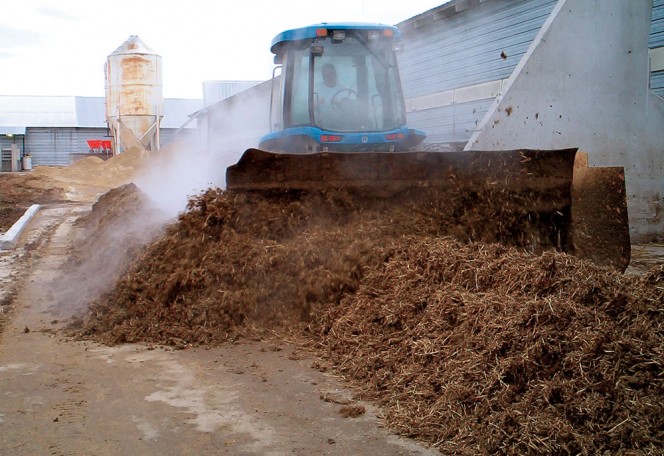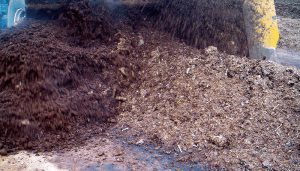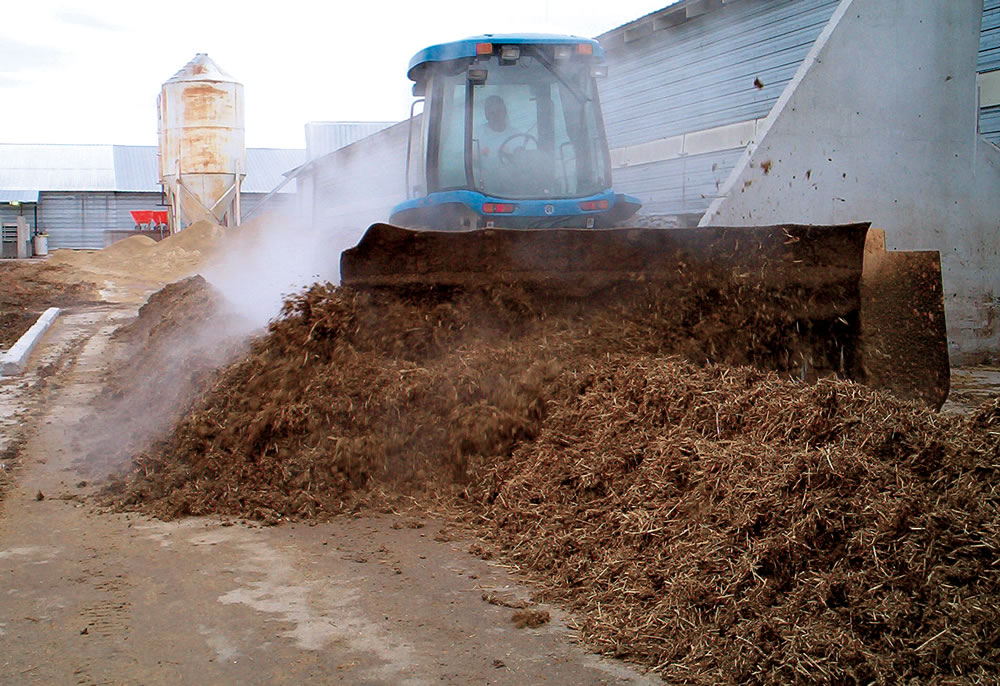Baer Brothers Egg composts manure from approximately 1.2 million laying hens. In 2015, composting also took care of birds killed by the avian flu outbreak.
Dan Emerson
BioCycle January 2016

A Brown Bear PTO composting aerator attached to a farm tractor is used to blend the feedstocks and agitate and aerate the composting piles. Photo courtesy of Brown Bear Corp.
In central Minnesota near the town of Lake Park, Baer Brothers Egg uses manure composting to control flies and odors, solving two problems that had been vexing the operation for years. Baer Brothers composts manure from approximately 1.2 million laying hens housed in natural convection high-rise houses. In the spring of 2015, the Baers also used composting to deal with mortalities from an outbreak of bird flu that killed more than 300,000 birds.

Manure and locally available carbon sources are mixed on concrete pads next to the high-rise houses. Photo courtesy of Brown Bear Corp.
The Baers began experimenting with composting around 1996, according to company President Amon Baer. “We had been battling a fly problem in our high-rise (chicken) houses,” he recalls. “We talked to an entomologist at the University of Minnesota who told us about products like sprays, chemicals and feed additives. The problem with those things is that the flies can build resistance to everything you use to kill them. But they can’t resist heat.” The Baers considered using heat to dry their manure. “But that is extremely expensive, so we thought, ‘Let’s try composting’.”
The manure is removed from the houses weekly, before the fly larvae hatch, and mixed on concrete pads next to the high-rise houses with a variety of locally available carbon sources. A Brown Bear PTOPA35D-10.5 attached to a farm tractor is used to mix the manure and amendment, as well as agitate and aerate the composting piles. The windrows are turned about two to three times during the first week to kill the fly larvae. “The fly larvae crawl out to the outside of the windrow to avoid the 150°F heat and then we turn the row to mix them back into the heat and kill them,” Baer explains. “We do this for about one week, then we move the material to our clay pad for final composting.”
Currently, the Baers actively compost around 5,000 tons/year of raw manure at about 73 percent moisture. The windrows are aerated weekly on the clay pad, with composting continuing for about 90 days. Fresh manure is continually added for moisture and to increase the nutrient value of the compost, until the carbon is completely consumed. “We use the Brown Bear turner to blend in the carbon and by continually adding raw manure to break down the carbon, we end up with about 2,000 tons of finished compost at 25 to 30 percent moisture,” Baer adds.
Over the roughly 20 years the Baers have been composting, they have used many different carbon sources, he notes. “We have used straw bales, sunflower hulls, sawdust, wood chips, corn stalks, and some trash paper that was piling up at the county. The straw or sunflower hulls seem to work the best, but any of the sources work. You have to learn the porosity of each different material you are working with to get composting off to a good start. Enough bulkiness is needed in the initial blend to allow oxygen inside the row. If you add too much manure and no oxygen can get in, it will not begin heating very well.”
He adds that if it’s done right, outdoor composting works, even in Minnesota’s extreme winter climate. “You might wonder how (outdoor composting) can actually work when it’s 20°F below and the snow is blowing. But when we dig into the pile, it’s still hot.”
Composting Mortalities
In the summer of 2015, the Baers composted a massive number of bird mortalities — due to the avian flu outbreak — in outdoor windrows, using a method stipulated by the U.S. Department of Agriculture. “USDA is very concerned about not wanting to spread the virus, and do not want the windrows turned until after 14 days so the material has gone through one heat cycle,” Baer explains. “After 14 days it can be turned again and then left to sit for another 14 days, through the second heat cycle.
“I had sold all of my compost before the birds ‘broke’ with the flu so when they broke, we had to start with a new carbon source. This summer with the bird mortalities, because of the thousands of tons of carbon required, we used a combination of products that we could source as soon as possible. We used wood chips, sunflower hulls, and the straw that we had on hand for what would have been my normal composting for the year. We are still in the process of adding additional manure into the composted birds to increase the nutrient content of the compost. We have orders in place for spring delivery of this compost.”
The Baers have been selling their finished manure compost to area farmers (including organic dairy farms) and golf courses for the past eight years, depending on word-of-mouth marketing. The final product is fly, odor and pathogen-free and is certified as organic. It is sold at the current market values for nitrogen, phosphorus and potassium, which is about $38/ton. Customers pick up the manure-based compost, either using their own trucks, or commercial service. “We have way more demand than we can supply,” Baer notes.
The Baers’ composting program eliminated the possibility of regulatory action by county and state agencies due to flies and odor. It won them an Environmental Achievement Award from the Minnesota Department of Agriculture.
Dan Emerson is a Contributing Editor to BioCycle.













